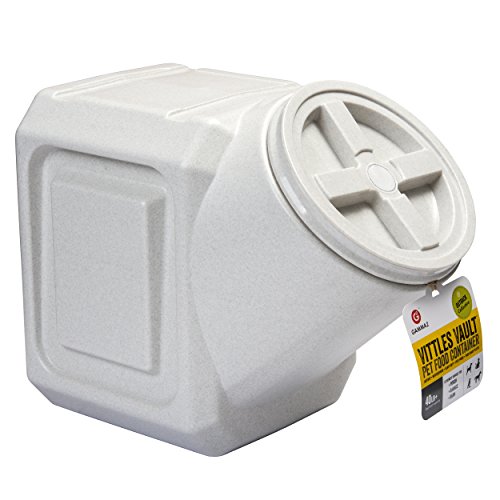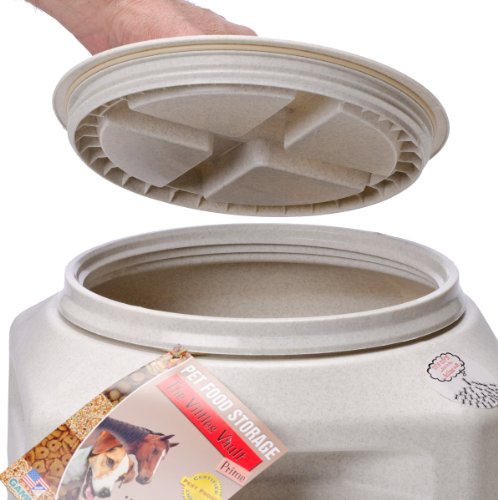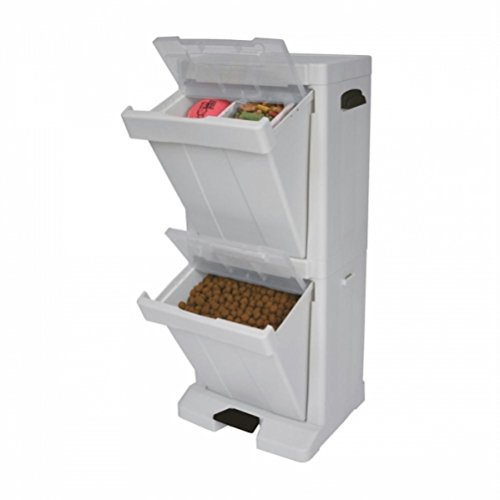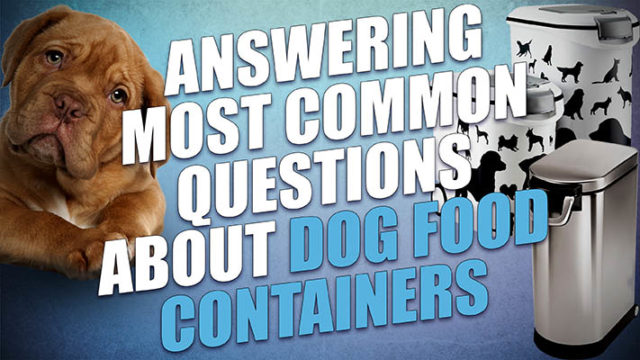
Table of Contents
- 23 Questions to Ask When Buying Dog Food Container
- How Much Dog Food Will It Hold?
- What is It Made From?
- Does It Contain Harmful Chemicals Like BPA?
- Does it Seal Completely?
- Will the Dimensions of the Container Fit Your Space?
- Does the Container Absorb Odor or Flavor?
- Is the Container “Dog-Proof”?
- Can the Container Be Used Indoors and Outdoors?
- How Portable Is It? Does It Have Wheels or Handles?
- If the Container Has Wheels, Do They Lock?
- Is the Lid to the Container Hinged or Removable?
- Is the Dog Food Container Made in the USA?
- How Sturdy Is the Dog Food Container?
- Is the Container Pest-Resistant?
- Is the Container Dishwasher Safe?
- Is the Container “Food-Safe”?
- Is the Dog Food Container Stackable?
- Does the Container Come with a Scoop?
- Is the Container Clear or Opaque?
- Are Other Sizes of the Same Container Available?
- What is the Diameter of the Container’s Opening?
- Is the Container True to Size?
- Does the Container Keep Out Moisture?
- Still Cannot Pick One?
Buying dog food containers might seem like a simple task, but if you’re like me and put a little too much thought into everything, there’s a lot to consider before making your purchase.
So today, we’re going to take a look at some of the things that you should consider before deciding on the right dog food container for you (and your pet) based on some of the most frequently asked questions from dog owners worldwide.
23 Questions to Ask When Buying Dog Food Container
Here are the questions you should ask yourself and research before buying.
How Much Dog Food Will It Hold?
This one is always answered on the purchasing page. Obviously, you need to ensure that the container you are choosing can hold enough dog food.
For example, if you purchase 30 lb bags of pet food, it’ll do you no good to buy a container that only holds 15 lbs because the remaining 15 lbs of food will be exposed to moisture, pests, air, and other contaminants.
It's best to start with calculating how much dog food you're buying weekly/monthly, how much of it you're storing and for how long.
Then, dog food container capacity may be measured in cups or pounds, depending on the manufacturer.
Every storage container page will have those details, so be sure to read carefully and compare capacity to your brand of kibble.
What is It Made From?
There are several materials commonly used in dog food containers. Stainless steel, plastic, and fabric (for travel containers) are the three most commonly used. All three have their own pros and cons, so it's best to choose the one that fits your needs.
Stainless steel is not as flexible for storage in cramped spaces, but it is more visually appealing.
Plastic dog food containers are a versatile option, but they are not visually appealing, and you need to ensure they don’t contain any harmful chemicals that could leach into your dog’s food.
Fabric storage containers are good for short-term travel, but they aren’t ideal for long-term storage and may sometimes include chemical components in interior lining materials.
Does It Contain Harmful Chemicals Like BPA?
As mentioned above, plastic and fabric containers may include harmful chemicals that can leach into your dog’s food.
Avoid containers with anything that sounds unsafe to you, and opt for containers made from food-grade plastic if you choose plastic containers.
Dangers and safety of pet food containers
On her podcast, Samantha spoke with an industry insider about the dangerous materials in dog food packages.
There's a lot to learn, but briefly here's what you should know: in terms of safety, you have five options that can be completely dog-friendly, and those glass containers, plastic, steel/aluminum/steel, cardboard and paper.
Containers made with either Bisphenol A (BPA) or Bisphenol S (BPS), Phthalates, or Polyvinyl Chloride (PVC) are some of the most harmful to pets.
The best way to avoid these dangerous chemicals in dog food containers is to read those labels fully.
Some manufacturers will also include phrases like PVC-free, BPA-free, and so forth.
If the manufacturer doesn't disclose what the container is made from, it's best to skip it and move on to the next one. There's no shortage of dog food containers here, so you always have a choice.
Does it Seal Completely?
To keep your dog's food fresh, pet food containers must be airtight and sealed completely.
Look for a container with a rubber gasket under the lid for the tightest seal. They should work similarly to Tupperware.
If it's not an airtight seal and works more like a trash can, then it's useless to you, and there's no reason to have it.
Will the Dimensions of the Container Fit Your Space?
If you have limited storage space in the kitchen (or wherever you keep your dog's food) and have an area in mind for your dog food container, measure the dimensions of your space beforehand to be sure it will fit.
Depending on which one you get, they can be pretty large, the size of a big trash can. Don’t forget to consider casters in the total height of your container, if there are any, too.
Does the Container Absorb Odor or Flavor?
Some dog food storage containers have a lining or coating within them that stops flavor and odor from being absorbed into the material of the container itself.
This helps to keep pet food fresh but should not be an alternative to washing out your dog food container regularly to avoid oil buildup.
Is the Container “Dog-Proof”?
Some dogs can be very driven when it comes to food. If this describes your dog, even if you keep the container somewhere “safe,” you should also be sure that the container is “dog-proof” to prevent thievery.
For example, the most popular line of dog food containers – Vittles Vault – has a twist and lock lid that your pup won’t be able to unscrew themselves (see below).
Dogs that aren’t prone to these types of “magic tricks” will usually do just as well with a snap-and-lock lid.
Can the Container Be Used Indoors and Outdoors?
Many dog owners inquire whether a dog food container is appropriate for indoor and outdoor use.
Technically, there is no (as far as I'm aware) dog food container for outdoor use, and that's because you should always store your dog’s food indoors.
Leaving a food container in direct sunlight can cause spoilage and sweating or cause chemicals within plastic containers to leach into your dog’s food.
Leaving food anywhere outdoors can also attract problem wildlife like bears and raccoons and will cause containers designed for indoor use to leak.
Briefly, in winter, when there's no sunlight, you can probably place any container outside for a short amount of time.
However, in general, keep your dog’s food storage container inside your home in a temperature-controlled, shaded area (just like you would do with your own food).
How Portable Is It? Does It Have Wheels or Handles?
Will you need to move your dog’s food regularly? If so, invest in a dog food container that can be easily moved.
For example, if you have hardwood, tile, or linoleum flooring, get a container with casters to make moving it easy.
If you have carpeted floors, look into dog food containers with handles.
This is particularly helpful if you buy your dog food in larger bags since these can cause food containers to become quite heavy and awkward to move.
If the Container Has Wheels, Do They Lock?
If you have tile, hardwood, or linoleum flooring and invest in a dog food container with casters, find out if they lock.
This isn’t a necessity, but it definitely makes refilling the container easier.
There are few things as annoying as wrestling a 30-pound bag of kibble while your dog's food storage container is rolling away from you!
Is the Lid to the Container Hinged or Removable?
Dog food containers with completely removable lids (meaning you can take the lid away with you) can be useful if you are storing them in areas where you may not be able to swing open a hinged lid.
For example, I store my dog’s food in a cupboard underneath the stairs, so it’s easier to take a lid on and off a container rather than try to swing open a hinged lid with limited vertical clearance.
If you have no limitation on space, however, hinged lids are generally more convenient.
Is the Dog Food Container Made in the USA?
Similar to dog food made in the USA, containers made in America are likely to be made using safer for pets materials that are quality tested to U.S. safety standards.
A pet food container manufactured in the U.S. is made from “FDA approved food grade material,” and it is always a safe choice because of stringent FDA standards.
Conversely, food containers made overseas, in China, for example, do not come with such assurances and can leach chemicals into your dog’s food.
How Sturdy Is the Dog Food Container?
Going back to “made from” topic, you have a choice of plastic, glass, steel and paper.
Clearly steel and glass will be most sturdy, paper/cardboard least reliable and plastic can vary.
Is the dog food container you are considering made from a flimsy cheap plastic or is it made from a thick, food grade plastic that is more likely to keep your dog’s food fresh?
Remember, you get what you pay for, so don’t go cheap because it’ll cost you spoiled dog food in the long run.
Is the Container Pest-Resistant?
If you know that there's a common problem with ants, cockroaches, beetles, or weevils in your home, you need to make sure that your dog food container is pest-resistant.
It should have a sealed lid, a sturdy construction, and no tiny cracks where pests can creep in.
And if you have a problem with pests, go with a removable lid container so that there is no chance of pests getting into the container from cracks around the lid hinges.
Is the Container Dishwasher Safe?
If you only buy small amounts of dog food at a time – for example, 5 lbs – you will only need a small dog food storage container.
Make sure that the container you choose is dishwasher safe and you can save yourself some dish-washing between container refills.
A quick tip: Be sure to remember that most “dishwasher safe” plastic products should be washed on the top rack of your dishwasher to prevent warping!
Is the Container “Food-Safe”?
When you buy a plastic dog food container, opt for “food-safe plastic” or “food-grade plastic.”
This means that the plastic has been approved by the FDA for the storage of human food and that the food kept in these containers is safe for human consumption.
Simple translation: the plastic will not leach chemicals into your dog’s food.
Is the Dog Food Container Stackable?
Have multiple pets who each have a different food type? Go for a stackable dog food container or one with several compartments (see below) so that you can save storage space while storing food for both pets safely.
There are a few versions of stackable containers, but those with an angled screw-on lid make accessing food much easier while still keeping it fresh.
Does the Container Come with a Scoop?
You can buy a dog food scoop for a few dollars, so don’t let this be a deciding factor in whether or not you should buy a particular pet food container.
Your priority when choosing a food container should be the safety of the food once stored inside it.
If the container you choose does come with a food scoop, it’s simply an added bonus.
Is the Container Clear or Opaque?
If you are storing your dog’s food container in a dark, cool spot, it doesn’t particularly matter whether the container is clear or opaque.
If, however, you are storing the container somewhere that it may experience some sunlight exposure, opt for an opaque container to protect food as much as possible from the sunlight.
Clear dog food containers are helpful when you have multiple dogs who eat different foods because you can see which food belongs to which dog without opening the container every time.
Are Other Sizes of the Same Container Available?
If you find a dog food container that checks all the boxes for you but is too large or too small, are other sizes available? Do your research and find out.
Optimally, you want a container that holds the amount of dog food that you buy in one bag.
For example, if you buy 30 lb bags of food, make sure that your container holds close to that number.
If the container holds less, you’ll wind up with stale dog food in the bag. If the container holds more, you’re going to be leaning into the container every mealtime to reach the food!
What is the Diameter of the Container’s Opening?
This may or may not matter to you, but dog food containers with larger openings are more easily accessible for feeding, refilling, and cleaning.
Smaller openings can make scooping out those last few cups of food difficult and definitely make cleaning frustrating.
Is the Container True to Size?
Look at the reviews as well as the product description of the dog food container you are considering.
If the product description states that it holds approximately 100 cups of food, look for any reviews that may say otherwise.
It’s important to know that not all kibble is the same size, so measuring by the pound isn’t the best way to determine the right container for your dog’s food.
For example, toy breed kibble may have 20 cups in one pound, and large breed kibble may have 15 cups in one pound because it’s a much denser kibble.
When you measure kibble by the cup, though, you are always going to have one cup, no matter how many ounces of kibble are in that cup.
Does the Container Keep Out Moisture?
Again, a tightly sealed container that is kept indoors should always keep moisture out.
Avoid cheaper containers without a sealing gasket and don’t keep your dog’s food container anywhere where excessive heat, humidity or moisture is a problem.
Still Cannot Pick One?
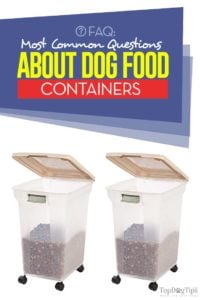 If you’re still having trouble deciding on the right dog food container for you, even after asking and answering all of the questions above, don’t be afraid to ask for recommendations and do more research.
If you’re still having trouble deciding on the right dog food container for you, even after asking and answering all of the questions above, don’t be afraid to ask for recommendations and do more research.
First, we have a huge list of 50 best dog food containers that you can research and see if anything looks good to you. Then, try to inquire people about their choices – ask your friends and family, ask online communities, ask your vet, ask anyone with a dog of their own and see what solutions work for them.
Picking the right type of pet food container is important because it's all about the safety of your dog's food.
You may buy the most expensive, healthy dog food on the market, but if it's not stored properly, that can result in bacterial and mite contamination, following with diseases and other health problems.
Choose wisely!
READ NEXT: 13 Tips on How to Store Dog Food Properly [Infographic]
Disclosure: We may earn affiliate commissions at no cost to you from the links on this page. This did not affect our assessment of products. Read more here and find full disclosure here.


